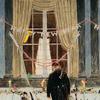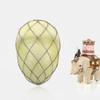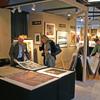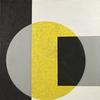Sweeping International Loan Exhibition at the Huntington to Explore Images of Latin American Nature From the Late 1400s to the Mid-1800s
- SAN MARINO, California
- /
- April 24, 2017
A sweeping international loan exhibition at The Huntington Library, Art Collections, and Botanical Gardens will explore how the depiction of Latin American nature contributed to art and science during the colonial era, at the time of contact with Europeans from the late 1400s to the mid-1800s. “Visual Voyages: Images of Latin American Nature from Columbus to Darwin,” on view in the MaryLou and George Boone Gallery from Sept. 16, 2017 to Jan. 8, 2018, will feature more than 150 paintings, rare books, illustrated manuscripts, prints, and drawings from The Huntington’s holdings as well as from dozens of other collections. Many of these works will be on view for the first time in the United States.
“Visual Voyages” will be complemented by a richly illustrated book, along with an array of other programs and exhibitions, including a sound installation by Mexican experimental composer Guillermo Galindo. The exhibition is a part of the Getty’s Pacific Standard Time: LA/LA initiative, an exploration of Latin American and Latino art that involves more than 70 arts institutions across Southern California.
“Despite notorious depredation of people and resources during the period, the brilliant work of a number of Latin Americans and Europeans helped to illuminate our understanding of the natural world,” said Catherine Hess, chief curator of European art at The Huntington and co-curator of “Visual Voyages.” “We aim to shed light on this relatively unexamined piece of the story—to show how beautiful, surprising, and deeply captivating depictions of nature in Latin America reshaped our understanding of the region and, indeed, the world—essentially linking art and the natural sciences.”
“Visual Voyages” looks at how indigenous peoples, Europeans, Spanish Americans, and individuals of mixed-race descent depicted natural phenomena for a range of purposes and from a variety of perspectives: artistic, cultural, religious, commercial, medical, and scientific. The exhibition examines the period that falls roughly between Christopher Columbus's first voyage in 1492 and Charles Darwin’s publication of On the Origin of Species in 1859, a work based largely on Darwin’s own voyage to the region in the 1830s.
“Information and materials circulated at an unprecedented rate as people transformed their relationship to the natural world and to each other,” said Daniela Bleichmar, associate professor of art history and history at the University of Southern California (USC) and co-curator of the exhibition. “Images served not only as artistic objects of great beauty but also as a means of experiencing, understanding, and possessing the natural world. These depictions circulated widely and allowed viewers—then and now—to embark on their own ‘visual voyages’.”
Bleichmar, who was born in Argentina and raised in Mexico, is an expert on the history of science, art, and cultural contact in the early modern period. Her publications include the prize-winning book Visible Empire: Botanical Expeditions and Visual Culture in the Hispanic Enlightenment (University of Chicago Press, 2012).
The Huntington’s three collection areas—library, art, and botanical—all contribute to “Visual Voyages.” Its Library is one of the world’s greatest research institutions in the fields of British and American history, art, and the history of science, stretching from the 11th century to the present, and includes such riches as the first European depiction of a pineapple and a rare 16th-century manuscript atlas that includes three stunning maps of the Americas. From The Huntington’s art holdings, Frederic Edwin Church’s monumental painting Chimborazo (1864) will be on display, depicting a Latin American landscape both real and imaginary. The Huntington’s 120 acres of gardens include several thousand plant species from Latin America, including pineapple, vanilla, cacao, and various orchids and succulents.
Visitor Experience
Designed by Chu+Gooding Architects of Los Angeles, “Visual Voyages” engages visitors through an evocative installation that includes interactive media, display cases of specimens and rare materials, and two walls almost completely covered with grids of visually arresting depictions of botanical specimens and still lifes.
The exhibition opens with a playful display of taxidermy mounts to make vivid the rare animals that captured the imagination of Europeans and were avidly collected during the period.
“Visual Voyages” then begins with a section on “Rewriting the Book of Nature,” in which manuscripts, maps, and publications show how nature came to be reconsidered in the first century of contact. This section includes a copy of the 1493 letter Christopher Columbus wrote to the King and Queen of Spain while on the return leg of his first voyage to the New World. He writes that the region is “so fertile that, even if I could describe it, one would have difficulty believing in its existence.” This section highlights the many contributions of indigenous Americans to the exploration of New World nature, among them two large-scale maps painted by indigenous artists in Mexico and Guatemala; a volume from the Florentine Codex, a 16th-century Mexican manuscript on loan from the Laurentian Library, Florence; and a spectacular feather cape created by the Tupinambá of Brazil.
Next, a gallery called “The Value of Nature” explores the intertwining of economic and spiritual approaches to Latin American nature. Commercial interests resulted in the investigation, depiction, and commercialization of such natural commodities as tobacco and chocolate. Indigenous religions considered the natural world to be infused with the divine, while Christian perspectives led observers to envision Latin American nature as both rich in signs of godliness as well as marked with signs of the devil—and needing eradication. Various depictions of the passion flower, a New World plant, show how the flower’s form recalled to missionaries the instruments of Christ’s Passion.
A third section, “Collecting: From Wonder to Order,” shows how the “wonder” that European collectors held for the astonishing material coming from the New World became a desire to possess and, later, to “order” this material, following systems of taxonomy and classification. On view will be a spectacular set of large paintings depicting Brazilian fruits and vegetables by the Dutch painter Albert Eckhout (ca.1610–1665) as well as 30 artful, vivid, and detailed drawings of botanical specimens painted by artists from New Granada (present-day Columbia, Ecuador, Panama, Venezuela, Peru, northern Brazil, and western Guyana), never before seen in the United States.
The final section of the exhibition, called “New Landscapes,” examines scientific and artistic perspectives on Latin America created in the 19th century, a period when a new wave of voyagers explored the region and independence wars resulted in the emergence of new nations. The Romantic and imperial visions of artists and scientists from Europe and the U.S. are juxtaposed with the patriotic and modernizing visions of artists and scientists from Latin America, who envisioned nature as an integral part of national identity. This juxtaposition can be seen visually in the pairing of The Huntington’s monumental Chimborazo by Church with the equally monumental Valley of Mexico (1877) by Mexican painter José María Velasco, on loan from the Museo Nacional de Arte in Mexico City.
“Visual Voyages: Images of Latin American Nature from Columbus to Darwin” is accompanied by a hardcover book of the same title written by Daniela Bleichmar, co-curator of the exhibition. In a narrative addressed to general audiences as well as students and scholars, Bleichmar reveals the fascinating story of the interrelationship of art and science in Latin America and Europe during the period. Published by Yale University Press in association with The Huntington, the 256-page book contains 153 color illustrations. $50.00. Available beginning in September 2017 at the Huntington Store and online at thehuntingtonstore.org


__Portrait_of_a_Young_100x100_c.jpg)











